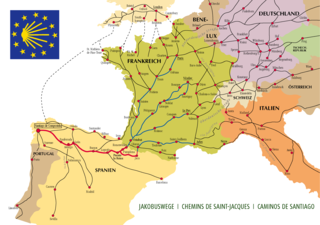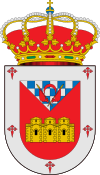
James, son of Zebedee was one of the Twelve Apostles of Jesus, traditionally considered the first apostle to be martyred.

Conques is a former commune in the Aveyron department in southern France, in the Occitanie region. On 1 January 2016, it was merged into the new commune of Conques-en-Rouergue.
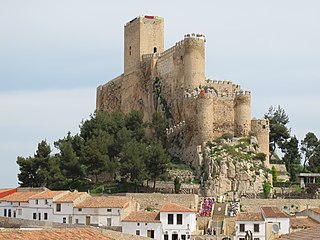
Almansa is a Spanish town and municipality in the province of Albacete, part of the autonomous community of Castile-La Mancha. The name "Almansa" stems from the Arabic المنصف (al-manṣaf), "half way of the road". The municipality borders with Alicante, Valencia and Murcia. Almansa is famous for its Moros y Cristianos festival from celebrated from the 1st to the 6th of May.
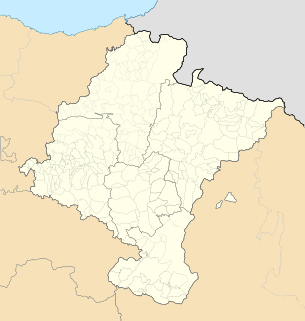
Luzaide is a Basque town in Navarre, northern Spain, located just a few kilometers from the French border and the village of Arnéguy.

Puente La Reina is a town and municipality located in the autonomous community of Navarre, in northern Spain.
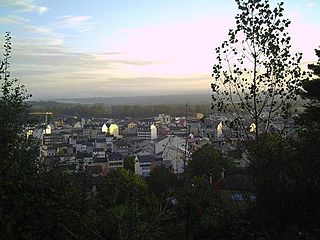
Sarria is a municipality in the province of Lugo, northwestern Spain, in the autonomous community of Galicia. Sarria is the most populous town on the French Way in Galicia, with 13,700 inhabitants. It is head of the region and the most popular starting point for the Camino de Santiago; many pilgrims choose Sarria because the distance from this point to Santiago allows them to cover the necessary kilometers to reach the Compostela. King Alfonso IX of León died in Sarria in 1230 while making a pilgrimage to Santiago de Compostela. Sarria also represents the point of entry to the beautiful landscapes, such as Os Ancares and O Courel, east of Galicia.
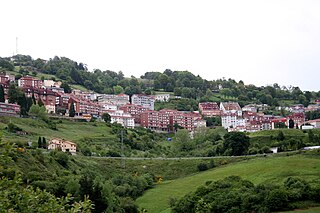
Tineo is a concejo (municipality) in the Principality of Asturias, Spain. It is situated on a small tributary of the Narcea River. It is the second-largest municipality in Asturias. It is bordered to the north by Valdés, to the south by Cangas del Narcea, to the west by Villayón and Allande, and to the east by Salas, Belmonte de Miranda and Somiedo.
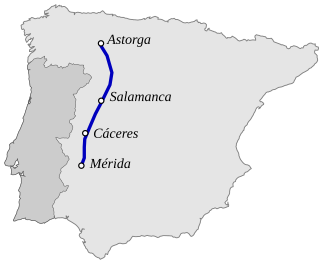
The Vía de La Plata or Ruta de la Plata is an ancient commercial and pilgrimage path that crosses the west of Spain from north to south, connecting Mérida to Astorga. An extended form begins further south in Seville and reaches north to the Bay of Biscay at Gijón. The path is used by the modern A-66 and AP-66 freeways, as well as by the older N-630 national road.

The Camino de Santiago extends from different countries of Europe, and even North Africa, on its way to Santiago de Compostela and Finisterre. The local authorities try to restore many of the ancient routes, even those used in a limited period, in the interest of charles.

Triacastela is a municipality in the province of Lugo, Galicia, Spain. It gets its name from the three castles that once stood here, none of which exist today. Norman (Viking) invaders in 968 A.D. pillaged here, eventually to be defeated at Cebreiro pass and driven off. They probably destroyed all three castles at that time.

The French Way is the most popular of the routes of the Way of St. James, the ancient pilgrimage route to Santiago de Compostela in Galicia, Spain. It runs from Saint-Jean-Pied-de-Port on the French side of the Pyrenees to Roncesvalles on the Spanish side and then another 780km on to Santiago de Compostela through the major cities of Pamplona, Logroño, Burgos and León. A typical walk on the Camino francés takes at least four weeks, allowing for one or two rest days on the way. Some travel the Camino on bicycle or on horseback.
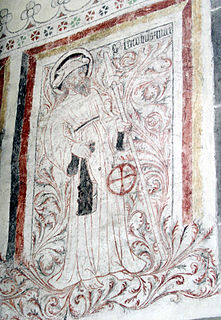
A pilgrim's hat, cockel hat or traveller's hat is a wide brim hat used to keep off the sun.
Juan de Ortega, better known as Saint John the Hermit, was a Spanish priest and hermit. A disciple of Dominic de la Calzada, he is best known for repairing roads and bridges along the Camino de Santiago. He also built a hospice as a shelter for pilgrims and founded the monastery of San Juan de Ortega.

Palas de Rei is a town in the province of Lugo, Galicia in northwestern Spain. It belongs to the comarca of A Ulloa.

Frómista is a municipality located in the province of Palencia, Castile and León, Spain. According to the 2009 data (INE), the municipality had a population of 822 inhabitants. In previous centuries, Frómista had a significant population supported by the farming of wheat.

Tosantos is a municipality and town located in the province of Burgos, Castile and León, Spain. According to the 2004 census (INE), the municipality has a population of 60 inhabitants. Tosantos is located on the Camino de Santiago de Compostela, a 1200-year-old pilgrimage route that runs through France and Northern Spain to the Spanish city of Santiago. The hamlet has a pilgrim hostel which is open from April through October and hosts up to 50 pilgrims a night.

Castrojeriz or Castrogeriz is a locality and municipality located in the province of Burgos, in the autonomous community of Castilla y León (Spain), the comarca of Odra-Pisuerga, the judicial district of Burgos, head of the town council of the same name and former head of the Castrojeriz judicial district.
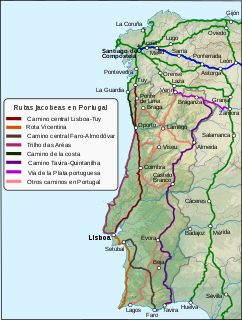
The Portuguese Way is the name of the Camino de Santiago pilgrimage routes starting in Portugal. It begins at Porto or Lisbon. From Porto, along the Douro River, pilgrims travel north crossing the five main rivers—the Ave, Cávado, Neiva, Lima and Minho—before entering Spain and passing through Padron on the way to Santiago de Compostela.
The Primitive Way is one of the paths of the Camino de Santiago. It begins in the old Asturian capital of Oviedo and runs west to Lugo and then south to Santiago de Compostela joining the more popular French Way in Melide for the last two hiking days. According to the Confraternity of St James, the Camino Primitivo is approximately 370 km in length.

